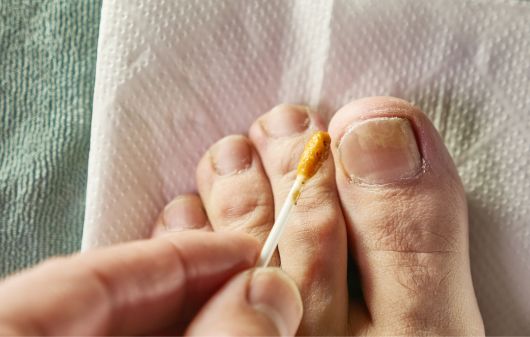Overview
Toenail fungus can be effectively treated with topical medications, but the best way to stop the infection from spreading and speed up the healing process is to maintain good foot hygiene.
Avoid going barefoot in public places, keep your feet dry at all times, and wear clean socks made of breathable materials to decrease the risk of reinfection further.
Although medication and home treatments can help with mild toenail fungus, seeing a doctor is best if the problem does not go away or worsens. Toenail infections can be difficult to treat, but this blog will walk you through the process, from home remedies to prescriptions to changes in lifestyle.
How to get rid of toenail fungus without going to the doctor?
Toenail fungus can be very annoying and painful therefore, before the condition gets worse, you should first try to seek consultation from an online doctor. You can also get a prescription from an online doctor. If a qualified professional suggests that you can rely on over-the-counter and home remedies to get rid of toenail fungus, you can use some of these. Here are some options you can consider:
Tolnaftate
Toenail fungus is no match for this multi-former, which comes in various forms, including liquids, powders, sprays, and creams.
Tea tree oil
The antifungal properties of tea tree oil make it useful in the fight against foot fungus.
Mentholated cream
As an at-home remedy, vapor rub has helped some patients with toenail fungus.
Snakeroot extract
This natural remedy is also very effective when treating fungal infections.
Ozonized sunflower oil
According to the research, there are no known side effects from using this natural remedy to combat the yeasts that cause foot fungus.
Eucalyptus oil
In addition to being fragrant, eucalyptus oil is effective against toenail fungus.
Oregano oil
Many people suffering from toenail fungus use oregano oil as a natural cure. One plant-based compound that can help fight toenail fungus is thymol, found in oregano oil.
Thymol is antifungal and antiseptic. Using a toothpick, apply oregano oil to the area under the nail where the fungus is located.
When treating toenail fungus, a combination of oregano oil and Vicks Vaporub applied to the afflicted nail can be quite effective.
While natural remedies such as oregano oil may help alleviate symptoms, it’s still best to talk to a doctor to get a correct diagnosis and advice on treating your condition.
Apple cider vinegar
Toenail fungus is treatable with apple cider vinegar, an all-natural solution. A cup of apple cider vinegar, two cups of water, and two or three tablespoons of baking soda make a 15-minute soak for your feet once or twice daily.
Because of its antifungal characteristics, apple cider vinegar could be useful in fighting off the infection.
While it is true that apple cider vinegar and other natural remedies can help, seeing a doctor for a proper diagnosis and advice on treating your unique health issue is still important.
“Home remedies can help you get rid of toenail fungus. However, you should always try getting a consultation from a doctor or a qualified professional instead of solely relying on home remedies and over-the-counter treatment.”
Dr. Mandy Lideman
Prescription medication
Toenail fungus is notoriously difficult to cure without the help of prescription drugs. Some medications prescribed by doctors are:
Oral antifungal drugs
When infections are bad, doctors usually prescribe medicine like Lamisil or Itraconazole (Sporanox). A new, healthy nail can grow in the place of the diseased one with the help of these pills.
Medicated nail polish
Mild infections of the nails can be treated with topical treatments such as Ciclopirox (Ciclodan, Penlac, Loprox) or Efinaconazole (Jublia).
Medicated nail cream
Fungal nail infections can be treated with creams that contain antifungal agents, like Naftifine (Naftin) and Tavaborole.
What are the complications of toenail fungus treatment?
The thickening, deformity, and discoloration resulting from untreated toenail fungus can hurt a person’s mobility and quality of life in general. The nail may need to be surgically removed in extreme cases.
When should I see a doctor?
You should consider a few things before visiting a doctor about toenail fungus. Seek the advice of a medical expert if the infection is serious and standard treatments are failing.
Seeing a doctor is also advised if the infection has progressed to other fingernails or if you suffer from preexisting diseases like diabetes that can worsen the effects of foot infections.
It is also crucial to consult a doctor if you prefer stronger treatments like antifungal pills or if you have any side effects while taking these drugs.
It is essential to seek the advice of a healthcare professional if you encounter serious nail infections that could necessitate removal or if you are considering treatments such as laser therapy, which may involve multiple sessions and may not be covered by standard healthcare services.
You must stick to your doctor’s orders if you want the best results from your treatment for fungal nail infection, which may include antifungal pills, nail paint, or laser therapy.
FAQs about toenail fungus
No, it is generally not recommended to get pedicures if you have toenail fungus. The tools and equipment used during pedicures can spread the infection to others or worsen your condition. It’s best to avoid pedicures until the fungal infection is fully treated and resolved.
No, it is advisable to avoid wearing nail polish during toenail fungus treatment. Nail polish can trap moisture and create an environment where fungi thrive. Additionally, it can make it harder to monitor the treatment progress and may interfere with the effectiveness of topical antifungal medications.
Untreated toenail fungus can lead to thickening, deformation, and nail discoloration. In severe cases, it may cause pain, discomfort, and affect mobility. Toenail fungus can spread to other nails if left untreated or lead to secondary bacterial infections.
The most successful treatments for toenail fungus include oral antifungal drugs like terbinafine and itraconazole, medicated nail polish containing ciclopirox or Efinaconazole, and medicated nail creams with antifungal agents like naftifine or tavaborole. These treatments are prescribed based on the severity of the infection and individual factors.







